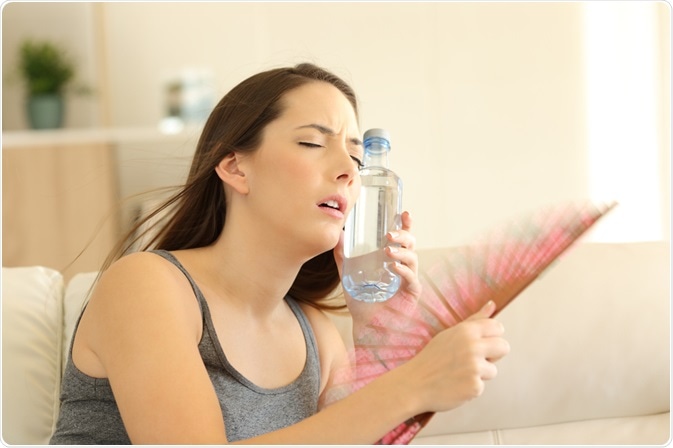Antipsychotic medications can impairer the body’s ability to regulate its own temperature and hot weather can lead to hyperthermia (heat stroke).
Antipsychotic medications are used to treat psychosis in a variety of psychiatric conditions such as schizophrenia, bipolar disorder, major depression, personality disorder, and agitation in dementia. However, some antipsychotics are also used to treat unrelated issues such as persistent hiccups and problems with balance.

Heatstroke. Image Credit: Antonio Guillem/Shutterstock.com
Schizophrenia and Heat Intolerance
One study aimed to investigate body temperature differences in response to exercise in male schizophrenic patients receiving treatment compared to healthy controls. Interestingly, schizophrenic patients initially had much lower skin temperatures compared to healthy controls before commencing exercise, though core body temperature was not different.
Upon exercise, body temperature rose the fastest and highest in the patient group compared to the control group. Upon rest periods, the temperature fell the most in the control group compared to the patient group suggesting that the patient group had consistently higher temperature throughout.
Indeed, further case studies have also shown the link between antipsychotic medication and heat stroke. A 49-year-old man was admitted to hospital in the summer of 2004 suffering heat stroke and re-admitted a second time the same summer for heat exhaustion. This individual had schizophrenia and diabetes mellitus and was receiving antipsychotic medications including benzhexol, chlorpromazine, and zuclopenthixol decanoate. The conclusion by the physicians was that the heatstroke was due to the medications he was receiving rather than any of his conditions themselves.
Antipsychotics and Impaired Thermoregulation/Heat Intolerance
Heat exhaustion is caused by hyperthermia and is the most common heat-related health condition that is typically non-life threatening and can be managed at home. This tends to occur in people involved in physical activity outdoors during high temperatures. Symptoms are usually brief and include irritability, rapid pulse/heartbeat, rapid breathing, profuse perspiration (sweating), dizziness, nausea, and cramps.
Heatstroke is a serious medical emergency characterized by excessive body temperature >40C, and whist heat stroke can affect anyone, its risk is highly exacerbated in people with chronic conditions and comorbidities and those receiving antipsychotic medications. Symptoms can include confusion, lethargy, coma, and seizures with a rapid pulse/heartbeat.
So, what leads to hyperthermia and heat stroke in those receiving antipsychotic treatments? Many antipsychotic medications tend to have some degree of anticholinergic effects, and these can inhibit sweating and reduce heat elimination from the body. Normally this would not be too much of an issue, but when combined with high temperatures in the summer, this can lead to severely impaired heat loss mechanisms from the body leading to heatstroke.
What to do in Hot Weather
Many antipsychotic medications can impair thermoregulation, largely making individuals susceptible to hyperthermia and heat stroke in high temperatures. As such, individuals receiving antipsychotic medications should exercise extreme caution in hot weather to minimize the risk of both heat exhaustion and heatstroke.
Specific things that people can do to minimize heat exhaustion include:
- Avoiding overexertion in warmer periods of the day
- Application of sun cream/lotion
- Increased intake of fluids to prevent dehydration – avoiding caffeine and alcohol
- Dressing in lighter clothing – both color and fitting
- Having regular food intake throughout the day to ensure adequate levels of sugar and salt
In summary, antipsychotic medications used to treat a variety of conditions can make individuals more susceptible to heat intolerance, heat exhaustion, and even heat stroke – especially in hotter weather. It is therefore advised that people receiving such medications exercise caution in the hot weather to minimize their risk of developing heat exhaustion.
References:
Further Reading
Last Updated: Jul 19, 2021